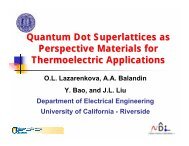Self-Heating Effects in GaN/AlGaN Heterostructure Field-Effect ...
Self-Heating Effects in GaN/AlGaN Heterostructure Field-Effect ...
Self-Heating Effects in GaN/AlGaN Heterostructure Field-Effect ...
Create successful ePaper yourself
Turn your PDF publications into a flip-book with our unique Google optimized e-Paper software.
Filippov and Baland<strong>in</strong>, Proceed. of the ACRS Nanotech Conf., San Francisco, USA , 2003.T a= 300K via its good thermal contact (see Fig.1).The heat-generat<strong>in</strong>g region is positioned next to thegate contact, on the dra<strong>in</strong> side, at the depth of0.023 µ m below the device top surface. The depth of0.023 µ m corresponds to the total thickness of theAl<strong>GaN</strong> cap layer shown <strong>in</strong> Fig.1. Our assumptions onheat source dimensions and depth are <strong>in</strong> l<strong>in</strong>e with theexperimental data of temperature distribution forsimilar devices [8]. S<strong>in</strong>ce Joule heat<strong>in</strong>g is thedom<strong>in</strong>ant heat<strong>in</strong>g effect for a given device, one canwriter rf = j ⋅ E . (2)This <strong>in</strong>dicates that the strong heat<strong>in</strong>g occurs <strong>in</strong> aregion with high electric field, and that our choice ofthe region geometry and position is rather realistic.To ga<strong>in</strong> an <strong>in</strong>sight <strong>in</strong>to the self-heat<strong>in</strong>g effectswe perform non-isothermal simulations for a numberof different heat-sources written as <strong>in</strong> Eq. (1). Theresults of simulations give temperature distribution <strong>in</strong><strong>GaN</strong>/Al<strong>GaN</strong> HFET as a function of dissipated power.F<strong>in</strong>ally we compare the self-heat<strong>in</strong>g <strong>in</strong> doped andundoped channel <strong>GaN</strong>/Al<strong>GaN</strong> HFETs. Earlier thesedevices have been compared <strong>in</strong> terms of their noiselevels [3]. The higher Al content <strong>in</strong> the barrier layer ofthe undoped channel transistor approximatelycompensates for the absence of the channel dop<strong>in</strong>gand makes comparative study mean<strong>in</strong>gful. Thelayered structure for the devices of both types isshown schematically <strong>in</strong> Fig. 1.Figure 1. Layered structure of the doped / undopedheterostructure field-effect transistor(HFET).We numerically solve the boundary value problem setby Eq. (1) us<strong>in</strong>g the f<strong>in</strong>ite element method. Theadaptive mesh is generated us<strong>in</strong>g the Delaunaytriangulation algorithm (see Fig. 2).Figure 2. A triangular mesh used <strong>in</strong> simulationswith the mesh size determ<strong>in</strong>ed from thestructure geometry and required accuracy.III. RESULTS AND DISCUSSIONThe results of the simulation of temperatureriseprofiles for the undoped and doped channel<strong>GaN</strong>/Al<strong>GaN</strong> HFETs on SiC substrate are shown <strong>in</strong>Fig. 3 (a-b). The dissipated power is P = 10 W/mm.Compar<strong>in</strong>g Figs. (a) and (b), one can see that at givenpower level the dop<strong>in</strong>g of the 50 nm active layer leadsto an approximately 15% <strong>in</strong>crease of temperaturemaximum for the L =1 µ m -long heat source. The<strong>in</strong>crease is 43% for the heat source with L =0.25 µ m.One can also notice from Fig. 3 that the doped <strong>GaN</strong>layer acts as a thermal <strong>in</strong>sulator that keeps the heat <strong>in</strong>the active channel and creates a hot spot. Highertemperature leads to mobility degradation and, thus, toa negative dynamic resistance of the device. For thesmaller device units (smaller gate length and dra<strong>in</strong> tosource separation), the negative effect of channeldop<strong>in</strong>g is even more pronounced. Some of thereported <strong>GaN</strong>/Al<strong>GaN</strong> devices had 100 nm - thickdoped layer [9] of <strong>GaN</strong> which is two times thickerthan we have considered here. For these devices the
Filippov and Baland<strong>in</strong>, Proceed. of the ACRS Nanotech Conf., San Francisco, USA , 2003.temperature <strong>in</strong>crease <strong>in</strong> the active channel is predictedto be even higher.In Fig. 4 we show the maximum temperature<strong>in</strong> the dra<strong>in</strong>-gate open<strong>in</strong>g of the HFETs as a functionof dissipated power. All four considered cases arecharacterized by almost l<strong>in</strong>er dependence. It isimportant to mention here that the results presented <strong>in</strong>Fig. 4 were obta<strong>in</strong>ed tak<strong>in</strong>g <strong>in</strong>to account temperaturedependence of the coefficient of thermal conductivity,which was extracted from the first-pr<strong>in</strong>ciple models ofRefs. [6-7].(a)(b)Figure 3. Temperature rise profiles <strong>in</strong> theundoped (a) and doped (b) channel <strong>GaN</strong>/Al<strong>GaN</strong>HFETs on SiC substrate. Note the differenttemperature scale <strong>in</strong> two figures.Figure 4. Temperature maximum <strong>in</strong> the dra<strong>in</strong>gateopen<strong>in</strong>g as function of the dissipatedpower per channel width P/W <strong>in</strong> Al<strong>GaN</strong>/<strong>GaN</strong>HFET. The results are shown for doped HFETwith 0.25 µ m heat-source length (curve 1);undoped HFET with 0. 25 µ m heat-sourcelength (curve 2); doped HFET with 1µ m heatsourcelength (curve 3); and undoped HFETwith 1 µ m heat-source length (curve 4).The developed simulation procedure that usesmaterials specific model for thermal conductivity canbe used for the device structure optimization. Thesimulation of self-heat<strong>in</strong>g effects <strong>in</strong> various<strong>GaN</strong>/Al<strong>GaN</strong> layered structures on different substrateswill help f<strong>in</strong>d<strong>in</strong>g parameters of the device structureoptimum for thermal management.
Filippov and Baland<strong>in</strong>, Proceed. of the ACRS Nanotech Conf., San Francisco, USA , 2003.IV. CONCLUSIONSWe have presented the results of the heat flowsimulation for <strong>GaN</strong>/Al<strong>GaN</strong> heterostructure field -effecttransistors. Temperature rise profiles and dependenceof the maximum temperature <strong>in</strong> the dra<strong>in</strong>-gateopen<strong>in</strong>g on the dissipated power have been obta<strong>in</strong>edfor such devices. Us<strong>in</strong>g the developed simulation toolswe compared different types of <strong>GaN</strong>/Al<strong>GaN</strong> HFETs,e.g. doped-channel vs. undoped-channel, with respectto their thermal management.AcknowledgementThis work has been supported by the Office ofNaval Research Award N00014-02-1-0352 to A.A.B.REFERENCES[1]. A. Baland<strong>in</strong> et al., IEEE Electron DeviceLetters, 19, 475 (1998).[2]. A. Baland<strong>in</strong>, et al., IEEE Trans on MTT, 47(8), 1413 (1999).[3]. A. Baland<strong>in</strong> et al., Appl. Phys. Lett., 75, 2064(1999).[4]. L. F. Eastman, et al., IEEE TED, 48, 479(2001).[5]. B.J. Thibeault, et al., IEEE Proceed of IEDM97-569 (1997).[6]. J. Zou, D. Kotchetkov, A.A. Baland<strong>in</strong>, et al.,J. Appl. Phys., 92, 2534 (2002).[7]. D. Kotchetkov, J. Zou, A.A. Baland<strong>in</strong>, et al.,Appl. Phys. Lett., 79, 4316 (2001).[8] M. Kuball , et al., IEEE Electron DeviceLetters, 23, 1 (2002).[9] Kaoru Inoue, et al., IEEE IEDM, 01-577(2001).















